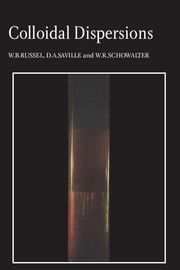Book contents
- Frontmatter
- ACKNOWLEDGEMENTS
- Contents
- Preface
- Units and physical constants
- Mathematical symbols
- 1 A Survey of Colloidal Dispersions
- 2 Hydrodynamics
- 3 Brownian Motion
- 4 Electrostatics
- 5 Dispersion forces
- 6 Forces due to soluble polymer
- 7 Electrokinetic phenomena
- 8 Electrostatic stabilization
- 9 Polymeric stabilization
- 10 Equilibrium phase behavior
- 11 Particle capture
- 12 Sedimentation
- 13 Diffusion
- 14 Rheology
- Appendix A Measured properties
- Appendix B Vector and tensor notation
- Author index
- Subject index
7 - Electrokinetic phenomena
Published online by Cambridge University Press: 05 August 2012
- Frontmatter
- ACKNOWLEDGEMENTS
- Contents
- Preface
- Units and physical constants
- Mathematical symbols
- 1 A Survey of Colloidal Dispersions
- 2 Hydrodynamics
- 3 Brownian Motion
- 4 Electrostatics
- 5 Dispersion forces
- 6 Forces due to soluble polymer
- 7 Electrokinetic phenomena
- 8 Electrostatic stabilization
- 9 Polymeric stabilization
- 10 Equilibrium phase behavior
- 11 Particle capture
- 12 Sedimentation
- 13 Diffusion
- 14 Rheology
- Appendix A Measured properties
- Appendix B Vector and tensor notation
- Author index
- Subject index
Summary
Introduction
Electrokinetic processes derive from interactions between macroscopic motion and diffuse electric charge. Here the emphasis is on phenomena used to characterize the electrical properties of particles in aqueous suspensions, and to introduce the subject some simple models will be described. The detailed discussions begin with electrophoresis, the motion of individual particles due to an external field. This technique is widely used to measure particle charge. The electrical conductivity of a suspension also reflects electrokinetic processes and is addressed next. The theory of conductivity is based on the same basic model as electrophoresis, extended to cover contributions from many particles. Measurements of mobility and conductivity are complementary, since one reflects events around an individual particle directly while the other averages over the particle population. The final topic concerns the response of colloidal dispersions to unsteady electric fields. Double layers are polarized by external fields and an unsteady field engenders relaxation processes at relatively low frequencies. Thus, studies of dielectric relaxation provide additional insight into electrokinetic behavior.
Examples of electrokinetic phenomena
Suppose that charged colloidal particles suspended in an ionic solution are somehow confined to a channel connecting two reservoirs. Flow of the solution sweeps part of the diffuse charge from one reservoir to the other, producing a streaming current. When there is no external connection between the reservoirs, charge accumulation produces a difference in electrical potential known as the streaming potential.
- Type
- Chapter
- Information
- Colloidal Dispersions , pp. 211 - 257Publisher: Cambridge University PressPrint publication year: 1989



